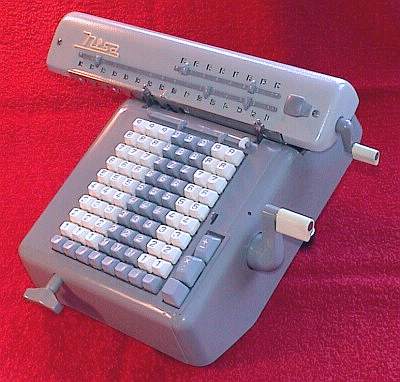previous <<==>> next
NISA - K2

T E C H N I C A L D A T A of the Mechanical Calculator NISA-K2
****************************************************************************
Inside: MONROE-LX CLONE ==>> Insight:"EasternBlock"LeftOver &"ColdWar"Relic!
****************************************************************************
Serial Number: 178102 / U3-28289 ( U3 = Year-Code = 1969/3rd Quarter )
Dimensions: (ca.) Width = 12_1/2" / 32 cm
Depth = 10_1/2" / 26 cm
Height = 4 " / 10 cm
Weight: (ca.) 8 lbs / 3.5 kg
Mechanics: 8*10 Full-Keyboard
Split-Stepped Drum / Geteilte Staffelwalze
10s Carry Mechanism
Counter Stepping Mechanism + Animation
Functions: Add, Subtract, Multiply, Divide
Registers: Input = 8 Decimals
Counter = 8 Decimals (NO Carry; Neg.Figures RED)
Arithmetic = 16 Decimals
Manufacturer:
NISA
Prosec/Nisa (=Neisse) , Czechoslovakia
1969
H O W T O U S E the NISA-K2
***********************************
BEFORE STARTING A TASK:
-----------------------
Turn MAIN CRANK in the top (idle) position.
RELEASE the REPEAT[x/:]Key by pressing the [+/-]Key above.
CLEAR the KEYBOARD by pressing the lower right key.
CLEAR the COUNTER unit by turning the carriage crank clockwise.
CLEAR the ARITHMETIC unit by turning the same crank counter-clockwise.
Lift and shift the CARRIAGE to the far left ( = POSITION 1).
ADDITION & SUBTRACTION:
-----------------------
Example: 123 + 45 - 6 = 162
ADD: Enter the first number (123) in the far right columns. Make a positive
(clockwise) turn with the main crank to transfer the number into arithmetic
unit. The counting unit displays the figure 1. Enter the second number (45).
Make a positive (clockwise) turn with the main crank to add the number. The
arithmetic unit displays the intermediate sum (168) and the counting unit
displays the figure 2.
SUBTRACT: Enter the third number (6). Make a negative (counter-clockwise)
turn with the main crank. The arithmetic unit displays the result (162) and
the counting unit is decreased by 1.
REMARK: NEGATIVE RESULTS are displayed in the arithmetic unit
as the COMPLEMENT of the next higher 10, 100, 1000, ...
Example: -12 = 99...9988
MULTIPLICATION:
---------------
Example: 123 x 45 = 5535
Clear counter and arithmetic units. Press the right REPEAT[x/:]Key.
Enter the multiplicand (123) in the far right columns. The multiplicator
(45) has two digits, so the arithmetic unit is moved to position 2 with a
clockwise turn of the T-Handle in front. Repeat making positive (clockwise)
turns with the main crank, until the first figure of the multiplicator (4)
will appear in the 2nd position of the counter unit. Move the arithmetic
unit with the T-Handle to position 1. Repeat making positive turns with the
main crank, until the second figure of the multiplicator (5) appears in the
1st position of the counter unit. The multiplication is done: The multi-
plicand (123) stays in keyboard, the multiplicator (45) in the counter unit
and the result (5535) is in the arithmetic unit.
DIVISION:
---------
Example: 22 : 7 = 3.1428571 Remainder 3
Division requires 3 steps:
(A) To Set the Dividend into Arithmetic Unit:
-----------------------------------------
For the maximum number of decimals, pull out the arithmetic unit to the
far right position. Enter the dividend (22) in the far right columns.
Make a positive (clockwise) turn with the main crank to transfer into
arithmetic unit.
(B) To Set the Divisor in the Keyboard:
-----------------------------------
Clear the counter unit by turning the carriage crank clockwise.
Enter the divisor (7) below the dividend (22).
Press the right REPEAT[x/:]Key.
(C) To Divide:
----------
Make negative (counter-clockwise) turns with the main crank until the
arithmetic unit shows an "underflow". Make one positive (clockwise)
turn with the main crank. Move the carriage with the T-handle to the
next left position. Repeat this procedure until the required number of
decimals are calculated...
The result (3.1428571) is in the counter unit ( in RED ), and the
remainder (3) is in the arithmetic unit. The divisor (7) stays in the
input unit, therefore an additional decimal can be estimated ...
( 4, cause 4 x 7 = 28).
R E M A R K S :
---------------
The COUNTER-FIGURES ( WHITE/RED ) follows the "MONROE-TYPE"-Scheme ...
Have a look at "Calculating Trickies" ...
impressum:
****************************************************************************
© C.HAMANN http://public.BHT-Berlin.de/hamann 04/24/07
|